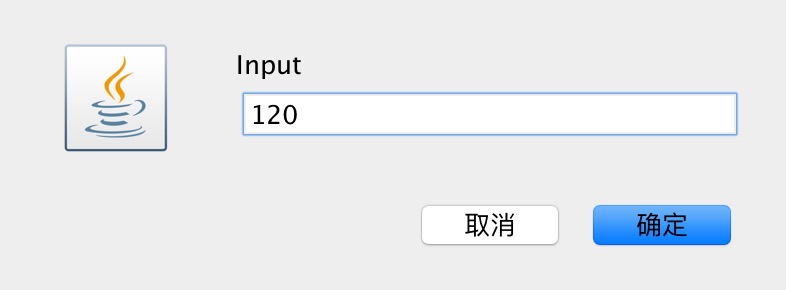Java语言程序设计(基础篇)
编程综合题 6.29
求最小公倍数
编写程序,提示用户输入两个整数并求它们的最小公倍数(LCM)。
两个数的最小公倍数是指这两书的倍数中最小的数。
例如,
8和12的最小公倍数是24,
15和25的最小公倍数是75,
120和150的最小公倍数是600。
求最小公倍数的方法很多,在本练习中采用以下方法:
为求两个正整数的最小公倍数,首先为每个数创建一个素数因子表,的第一列包含所有素数因子,第二列为该数中对应素数因子出现的次数。
例如,120的素数因子为2,2,2,3,5,所以120的素数因子表如下所示:
120的素数因子 出现次数
2 3
3 1
5 1
150的素数因子 出现次数
2 1
3 1
5 2
两个数的最小公倍数由这两个数种出现频率最高的因子构成,所以,120和150的最小公倍数为2*2*2*3*5*5=600。其中2在120中出现了3次,3在120中出现了1次,5在150中出现了2次。
提示: 可以用二维数组表示素数因子表,编写 getPrimeFactors(int numer)方法,使其为素数因子表返回一个二维数组。
以下是我编程中的思路变化过程:
**LeastCommonMultiple1.java**
import javax.swing.JOptionPane;
public class LeastCommonMultiple1 {
static int MAX=10;
public static void main(String[] args) {
//get the integers from a dialog
String num1=JOptionPane.showInputDialog(null,"Input","Input Dialog",JOptionPane.QUESTION_MESSAGE);
//creat a array then initialize it ;
int[][] primeFactorList1=new int[2][MAX];
for(int j=0;j<primeFactorList1[0].length;j++){
primeFactorList1[0][j]=1;
primeFactorList1[1][j]=0;
}
leastCommonMultiple(Integer.parseInt(num1),primeFactorList1);
//output the list to check ;
System.out.println(Integer.parseInt(num1)+" 's table of factors are");
for(int i=0;i<primeFactorList1.length;i++){
for(int j=0;j<primeFactorList1[0].length;j++){
System.out.print(primeFactorList1[i][j]+" ");
}
System.out.println("");
}
String num2=JOptionPane.showInputDialog(null,"Input","Input Dialog",JOptionPane.QUESTION_MESSAGE);
//creat a array then initialize it ;
int[][] primeFactorList2=new int[2][MAX];
for(int j=0;j<primeFactorList1[0].length;j++){
primeFactorList2[0][j]=1;
primeFactorList2[1][j]=0;
}
leastCommonMultiple(Integer.parseInt(num2),primeFactorList2);
System.out.println("\n"+Integer.parseInt(num2)+" 's table of factors are");
for(int i=0;i<primeFactorList2.length;i++){
for(int j=0;j<primeFactorList2[0].length;j++){
System.out.print(primeFactorList2[i][j]+" ");
}
System.out.println("");
}
//calculate the least common multiple by the two list; that is a bug which need to fix!
int leastCommonMultiple=1;
for(int j=0;j<primeFactorList1[0].length;j++){
if(primeFactorList1[0][j]==primeFactorList2[0][j]){
if(primeFactorList1[1][j]<primeFactorList2[1][j])
leastCommonMultiple*=Math.pow((double)primeFactorList1[0][j], (double)primeFactorList2[1][j]);
else
leastCommonMultiple*=Math.pow((double)primeFactorList1[0][j], (double)primeFactorList1[1][j]);
}
else{
leastCommonMultiple*=Math.pow((double)primeFactorList1[0][j], (double)primeFactorList1[1][j]);
leastCommonMultiple*=Math.pow((double)primeFactorList2[0][j], (double)primeFactorList2[1][j]);
}
}
//output the LCM on both of console and dialog ;
String result=String.format("\n"+leastCommonMultiple+" is the least common multiple of "+Integer.parseInt(num1)+" and "+Integer.parseInt(num2));
System.out.println(result);
JOptionPane.showMessageDialog(null, result);
}
//it is able just to handle the integer whose number of factors is less than 10, and that's why i set a const argument "MAX" which is 10 default ;
public static void leastCommonMultiple(int number,int[][] primeFactorList){
int integer=number;
if(integer>=2){
for(int factor=2;factor<=integer;factor++){
if(integer%factor==0){
//load into the factor list;
updatePrimeFactorList(factor,primeFactorList);
integer=integer/factor;
//System.out.print(factor+" ");
leastCommonMultiple(integer,primeFactorList);
break;
}
//the following "else" is not essential,it may not miss somewhere
else
continue;
}
}
// else
// JOptionPane.showMessageDialog(null, "the number you put is not valid!","Error",JOptionPane.INFORMATION_MESSAGE);
}
//update the prime factors list ;
public static void updatePrimeFactorList(int num,int[][] primeFactorList){
for(int j=0;j<primeFactorList[0].length;j++){
if(primeFactorList[0][j]==num){
primeFactorList[1][j]++;
break;
}
else if(primeFactorList[0][j]==1){
primeFactorList[0][j]=num;
primeFactorList[1][j]=1;
break;
}
else
continue;
}
}
}
Result of test :


从输出这里你可以看到我采用的是二维数组primeFactorList:int[2][MAX]的形式存储整数的素数因子表,primeFactorList[i][0]存放素数因子,相应的 primeFactorList[i][1]存储相应素数因子出现的次数,并且开始用1初始化 primeFactorList[i][0],用0初始化 primeFactorList[i][1]。
**Bugs** - **很显然,如上图输出结果所示,在素数因子表里面存在着我们编程方式留下 痕迹,








 这篇博客探讨了如何使用Java编程解决求两个正整数最小公倍数的问题。作者通过编程实例展示了初始的算法设计,以及逐步优化的过程,包括去除冗余数据,修复素数因子表的错误,处理特殊情况如输入为素数或1的逻辑,并强调了代码优化和错误处理的重要性。
这篇博客探讨了如何使用Java编程解决求两个正整数最小公倍数的问题。作者通过编程实例展示了初始的算法设计,以及逐步优化的过程,包括去除冗余数据,修复素数因子表的错误,处理特殊情况如输入为素数或1的逻辑,并强调了代码优化和错误处理的重要性。

 最低0.47元/天 解锁文章
最低0.47元/天 解锁文章

















 6万+
6万+

 被折叠的 条评论
为什么被折叠?
被折叠的 条评论
为什么被折叠?








